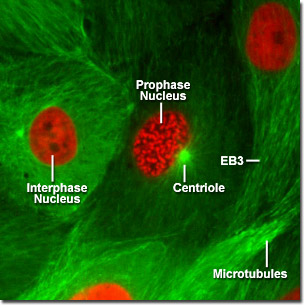Image Galleries
Featured Article
 Electron Multiplying Charge-Coupled Devices (EMCCDs)
Electron Multiplying Charge-Coupled Devices (EMCCDs)
By incorporating on-chip multiplication gain, the electron multiplying CCD achieves, in an all solid-state sensor, the single-photon detection sensitivity typical of intensified or electron-bombarded CCDs at much lower cost and without compromising the quantum efficiency and resolution characteristics of the conventional CCD structure.
Product Information
Digital Video Gallery
Epithelial Cell Mitosis

The digital video sequences presented in this section feature epithelial cells undergoing mitosis as visualized through the highly dynamic interactions between fluorescently labeled red histones (mCherry) and green EB3 (mEmerald). The fluorescent protein known as mEmerald is a high-performance version of EGFP that is significantly brighter and also matures faster. When coupled to the microtubule end-binding protein EB3, traces of the fluorescently labeled positive microtubule ends can be observed traversing the cytoplasm and forming the spindle during mitosis. Compare these digital videos with those of EGFP-tubulin presented in another section.
Video 1 - Run Time: 10 Seconds - Both the centrioles of the surrounding cells and the chromatids of the cell undergoing mitosis are clearly imaged with mCherry and mEmerald fluorescent protein. Choose a playback version: Streaming Video (1.9 MB), Progressive Download (1.9 MB), and MPEG Download (18 MB)
Video 2 - Run Time: 12 Seconds - The centrioles and microtubule network are clearly visible as an LLC-PK1 cell undergoes mitosis. Choose a playback version: Streaming Video (1.6 MB), Progressive Download (1.6 MB), and MPEG Download (17 MB)
Video 3 - Run Time: 11 Seconds - A good view of the metaphase of mitosis is possible in this LLC-PK1 cell. Choose a playback version: Streaming Video (2.2 MB), Progressive Download (2.2 MB), and MPEG Download (22 MB)
Video 4 - Run Time: 16 Seconds - This video provides a brightly illuminated view of the latter stages of mitosis, from the metaphase onward. Choose a playback version: Streaming Video (2.8 MB), Progressive Download (2.8 MB), and MPEG Download (27 MB)






